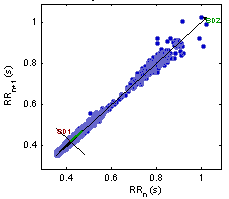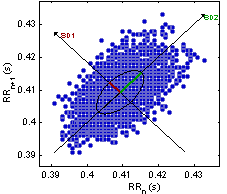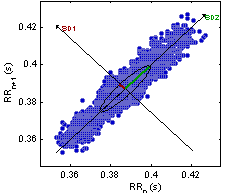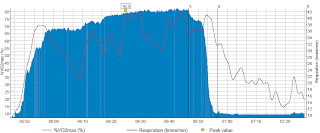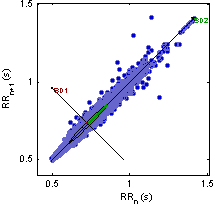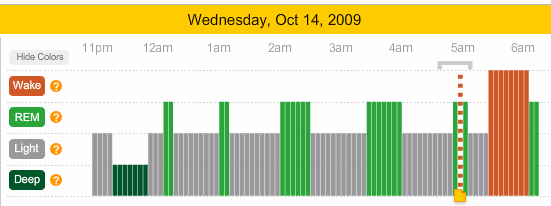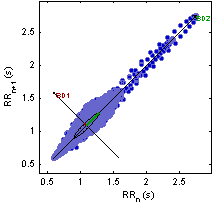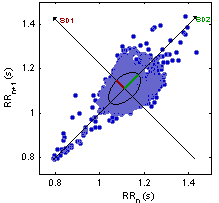Numbers From The Heart
Alexandra Carmichael
April 28, 2010

A meditative mandala in Nepal (photo credit: Wonderlane)
Do you meditate, run, or sleep? Ramesh Rao does all three. Not only that, but this grounded Professor of Electrical and Computer Engineering at UCSD tracks his heart rate and brain waves while he’s doing these activities.
We heard a bit about quantified meditation from Robin Barooah at a recent San Francisco QS meetup. Professor Rao takes it to another level. I had the pleasure of meeting him and hearing his story this past week. He graciously agreed to let us post his findings.
In his words:
Electrical signals that trigger the beating of the heart are not quite periodic and the larger the variation the healthier the heart! A transplanted heart shows very little heart variation. Alienated. Since 1965, when the first findings on HRV were reported, numerous studies have documented the correlation between lowered HRV measures and increased fatigue, stress, exhaustion both physical and mental.
A Task Force of The European Society of Cardiology and The North American Society of Pacing and Electrophysiology concluded in 1996 that:
Heart rate variability has considerable potential to assess the role of autonomic nervous system fluctuations in normal healthy individuals and in patients with various cardiovascular and non cardiovascular disorders.
A lay reading of the scientific literature suggests that HRV entrains many physiological, psychological and emotional responses. As a result HRV is a rich, if garbled, source of invaluable information. For close to 21 months now, I have been gathering comprehensive HRV data during my early morning aerobic work and nightly yoga practice. I also have an assortment of interesting additional recordings: a four day long trace, a recording of the bliss of sedation during a colonoscopy procedure and meditation sessions.
An animation on WebMD illustrates the electrical signature of a heart beat into the P, QRS and T segments and correlates it with activity of the chambers of the heart. The QRS complex, the strongest of the three, triggers the ventricular contractions and is the easiest to monitor with consumer grade heart rate monitors like the Polar RS800. These devices record successive R peak to R peak values of the QRS waveform – the so-called RR data. Devices like the Polar come with software that do some off line HRV analysis and the wrist unit can be configured to display real time HRV.
For a more thorough analysis one can download Kubios HRV, freely distributed by Professor Pasi A. Karjalainen’s Biosignal Analysis and Medical Imaging group at the University of Kuopio in Finland. This software reads RR-recordings stored in Suunto‘s SDF or STE formats or Polar’s HRM format and calculates twenty-six widely studied measures of HRV from the raw time series. It has a
dashboard like interface that allows users to interactively select segments of the data and understand the results and even fine-tune the algorithms. A sample of the report it produces is shown alongside.
The figure in blue at the very bottom is the Poincare plot. One forms pairs [RR(n), RR(n+1)] where RR(n) is the n-th recorded RR interval and marks these points on a two axis graph to form this chart. The Poincare plot of an unvarying transplanted heart would simply be a point. Beat to beat variations of a normal heart smears the points in a circular shape. Exertion that lasts for minutes induces a steady lowering of the RR intervals and the Poincare plot turns elliptical. One can read off the beat to beat variation from the minor axis (SD1) and the longer term variation from the major axis (SD2) of an ellipse inscribed within the cloud.
Here is what my Poincare plot looked like during an 8.4 mile run on a flat beach.You see a narrow comet like form flying towards the south west corner on account of the exertion. On this run, SD1 was about 5 ms and SD2 measured 75 ms. Against an average inter beat interval of about 420 ms, SD2 of 5 ms suggests that the heart was pumping hard with little room for play.
HRV Kubios also let me zoom in and see how settled the heart had been during a twenty minute segment in the middle of the run before I picked up my pace towards the end.
Incidentally I burned 935 calories on this run or about 110 calories per mile. This is quite a low number for me and shows the higher efficiency of barefoot running on sand!
The heart reacts to numerous external stimuli ranging from loud noises to sustained physical exertion. Breathing patterns respond similarly to some of the stimuli but react differently to other stimuli. Filtering algorithms can help infer a number of interesting measures from the RR data in conjunction with some additional data. A dissertation by S. Saalasti at the University of Jyvaskyla in Finland develops a case for a Neural Network based approach to inferring respiration patterns from the observed RR HRV variations. Firstbeat Technologies incorporates such algorithms into its FirstBeat Athlete and FirstBeat Pro products to translate RR data into a time series representation of Respiration rates, %VO2max, Energy Expenditure, EPOC (Excess Post Exercise Oxygen Consumption) and more.
Respiration rate data help refine running techniques like Danny Dreyer’s ChiRunning method that calls for rhythmic deep breathing to reduce the stress of running. Here is a FirstBeat Athlete snap shot from a run in which I layered on four distinct Chi running techniques between 5:50 and 6:10 AM. My respiration rate halved during that period but then I let go of my focus, and my breathing meandered and the
exertion increased.
%VO2max data helps uncover one’s endurance limits. If the pace is too high or the incline too steep, one can outrun one’s aerobic capacity and draw on anaerobic reserves. Lactate levels at rest are close to 1 micro Moles (mM). For all of us, we go into anaerobic mode at about 4 mM and shortly thereafter the level spikes at 10 mM and we quit. Conditioning simply influences how high VO2 can get before we hit the 4 mM anaerobic threshold. Running for longer than 6 miles is fueled mostly by aerobically generated energy. FirstBeat Athlete shows me currently running at 85% of VO2max for longer than 30 minutes. So the lactate level in my blood must not exceed 4 mMol even when my VO2 is 85% of VO2max.
I look forward to long endurance runs and over time my ankles and hips have stopped hurting. I started taking Glucosamine and Chondartin supplements and now the knees hurt less and the pain recedes more quickly. A day after it had rained I went on a long run around San Elijo Lagoon. After 5 miles of stepping around shallow muddy puddles with quick twists and turns, my right knee buckled. I completed the 10.7 mile loop stopping to walk every time I felt the short muscles that lace around my knee twitch and pull. The pain was unfamiliar . I wonder if I had inadvertently over worked my fast twitch muscles. How does one score a run that combines exertion with breaks that help with recovery? Excess Post Exercise Oxygen Consumption (EPOC ) measure addresses just that question.
At the heart of the EPOC calculation is a model to track the effect of changes in exertion using single or bi-exponential curves to track changes in VO2 consumption. These so called ON-OFF dynamics can then be integrated over the period of an exercise to derive a final figure for EPOC. The brute force way to compute EPOC would be to simply measure the oxygen consumed by a subject from when an exercise session ends to when the consumption rate returns to its base line value. The innovation lies in predicting EPOC by inferring the ON-OFF transition moments based on heart rate variations. The knee buckling run around San Elijo burned 1100 calories and produced an EPOC score of 174 right when my knee buckled.
Four days later a 6.8 mi run on a treadmill burned just 730 calories but generated an EPOC of 204.
My Polar unit predicts that my absolute VO2max is 54 ml/kg/min (up from 39 ml/kg/min prediction in May 2008). Based on published norms on Aerobic Fitness, this rating would put me in the 97th percentile of North American men even if I were 32! Around the time I turned 51, I took a more comprehensive Polar BodyAge score that used a PC specially rigged up with heart rate monitors and strain gauges to gather data on HRV, Strength, Flexibility and a few other measures and proclaimed my body age to be 38.
In the year and a half since I reset my lifestyle, I have grown attached to Yoga much more than running. I happen to practice six different styles of Yoga largely due to offerings available late at night. I have come to appreciate the variations in the styles of Yoga and the expression of each teacher’s (Yogic) personality. The irony of getting attached to a practice that teaches detachment got me to take a look at Poincare plots of different styles of Yoga. In Ashtanga Yoga one transitions to a different asana every five breaths or so. To preserve the heat generated, you flow through Surya Namaskars whenever the flame within flickers. Die hard Ashtangis would find some humor in the heating of studios for “Hot Yoga” classes.
Here is data from a September 30th Ashtanga Yoga practice. During this session, SD1 measured 13.5 mS and SD2 was 180 ms against an average of 730 ms. So Ashtanga made more room for short and long term variations than running.
In restorative Yoga one holds a series of gentle poses for as long as 5 minutes each? I practice this style every Sunday evening after the week’s longest run in the morning. SD1 on October 4th was 33.8 ms, SD2 was 226 ms and the average RR interval was 1 second. My heart rate dipped to 24 beats per minute on this day. The heart seems to enjoy restorative Yoga after the exertion of the morning. A reading of the axes of the Poincare plot will show that numerous RR readings were in excess of 2 seconds; long enough to almost skip a beat. Could it get better?
On November 22nd, during thirty minutes of guided meditation, right after restorative yoga, my mind and breath got still enough for the heart to register an SD1 of 54.5 ms. Something special happened this day.
First, some corroborating evidence. For many months now, I have been wearing the GoWear device (except when I am in the shower, syncing up or recharging the device). The device records calories expended, counts the steps taken but more interestingly it records galvanic skin response and uses it to discriminate between sitting still, lying down and sleeping.
Here is a fragment of the GoWear sleep trace from November 22nd. Restorative Yoga and the meditation session went from 4:00 to 6:15 PM. GoWear shows me as active during the entire Yoga session, which ran from 4:00 to 5:30 PM, then lying down from 5:30 to about 5:45 (the light Grey region), at 5:45 GoWear sees me going into a sleep state (the dark region) before I got up and went home. I was by no means asleep between 5:45 and 6:15, but I was in a different state. I had mentioned FirstBeat Athlete’s implementation of algorithms that infer breathing rates from HRV data. The next FirstBeat trace shows my heart rate and inferred respiration for the combined restorative Yoga and Meditation session for the evening. You can see that around 5:45 PM my heart rate and breathing lowered and synchronized with each other. Some of the guidance during a meditation session is a gentle urging to open the heart and connect it to the breath and apparently that happened. But why did the data register as sleep? Was there something
special going on?
When I enter into Shavasana, the corpse pose, at the end of my Yoga practice, I regularly see a pattern of gold and deep purple rings that alternately engulf each other. I sometimes see an eye in the center of the pattern, a human eye with a dark pupils, brown iris, the whites, eyelids and eyelashes. Surreal as it seems, these visions recur. I am as comfortable with that observant eye as if it were my own. I wonder if we have an image of ourselves that surfaces when all is still?
On November 22nd, when the Kubios HRV Poincare Plot showed my highest recorded beat to beat heart rate variation, when GoWear said I had entered the sleep state and when FirstBeat Athlete found my heart rate and breath to be in harmony, I saw a new pattern behind my closed eyes. I saw a gently swirling ornate Greek Cross. The urge to make sense of that vivid recollection drove me to uncover all these correlations in the data I had been gathering with my various devices.
Are religious icons formed from such shared visions? A few meditators, that I have spoken with, acknowledge it and gently suggest that one can get to something that lies beyond these lights. Occasionally I experience that in a backwards manner, when a fellow practitioner coughs during Shavasana and jars my mind enough to turn on the lights.
I went looking for an explanation and found a Masters Thesis! In her dissertation on “Exquisitely Simple or Incredibly Complex: The Theory of Entoptic Phenomena” Suzanne Carr at the University of Newcastle upon Tyne writes that:
The theory of entoptic phenomena is simple enough: phosphenes, form constants (or entoptics) are generated in the neural system, and anyone can see them; these visions are enhanced by the taking of hallucinogenic drugs; these drugs may have been taken as part of a shamanistic ritual and the images ‘seen’ were then drawn by the
visionary.
Carr’s study examined the work of child psychologists, psychiatrists, neurophysiologists, artists, ethnopharmacologists, anthropologists, and archaeologists on Entoptic Phenomena.
In her thesis she cites the work of Max Knoll and his colleagues at the Technische Hochschule in Munich who induced phosphenes through electrical stimulation.“He found that pulses in the same frequency range as brain waves (from 5 cycles per second to about 40) were most effective in producing phosphenes. He tested more than 1000 people and found that all of them, after becoming dark-adapted, saw at least a flickering light; by concentrating carefully about half of the subjects also a saw geometric figures” (Oster 1970:85). Figure 1 illustrates 15 of the images outlined by Knoll (after Oster 1970:87).
I see a form that is roughly a rotating superposition of the spiral form in the middle row and the cross in the lowest row with no external electrical or drug induced stimulation.
Philip T. Nicholson closes the circle by relating phosphenes to descriptions of luminous visions in Vedic and Yoga texts in “Soma Code: Parts I-III“. Nicholson also has a similar treatment that ferrets out allusions to luminous visions in the Early Dao tradition.
Page seventy-six from Nicholson’s Soma Code article appears alongside. Nicholson has a page full of citations of the original sources that first documented these phosphenes.
I observe patterns A1 and C2. It was especially gratifying to come upon pattern C2, and realize that I am not alone in seeing this anthropomorphic image and that my mind had not somehow been waylaid.
The gold and purple rings, the floating eye, the Greek Cross and these other patterns have long been experienced and remembered through religious and cultural symbolism and even carved in stone. Today, these entopic phenomenon are the subject of a number of reductionist studies.
Ancient Shamans and Rishis seemed to have understood the practical value of these phosphenes as harbingers of a quiet mind.
How does meditation compare with sleep? I have been using the Zeo to track brain waves and record the phases of my sleep. Here is a parsing of my sleep on the night of October 14th. The alarm went off at 4:45 AM on that day but I stayed in bed till about 6:00.
From about 11 PM to 5:00 AM, my entire sleep period that night, my SD1 was 41.7 ms and SD2 was 275.
During the, Zeo tagged, Deep Sleep period between 11:15 and 11:45 PM, HRV showed an SD2 of 89.2 ms and an SD1 of 51.2 ms. My deepest meditation spell produced an SD1 of 54.5ms, which seems to challenge the stage four, delta-theta, deep sleep! Yogis have always held meditation to be a deeper form of relaxation than sleep. Now, I have the data to prove it, albeit for N= 1!
A final word; while I have drawn attention to devices, data and algorithms, the states they measure have long been experienced, experimented with and the understanding has been passed on through the generations in different tongues. I have cited published sources explicitly but left unnamed influences, teachers and healers who helped me on this journey. My experiences are hardly unique, but details relevant to the practice remain to be elaborated.


